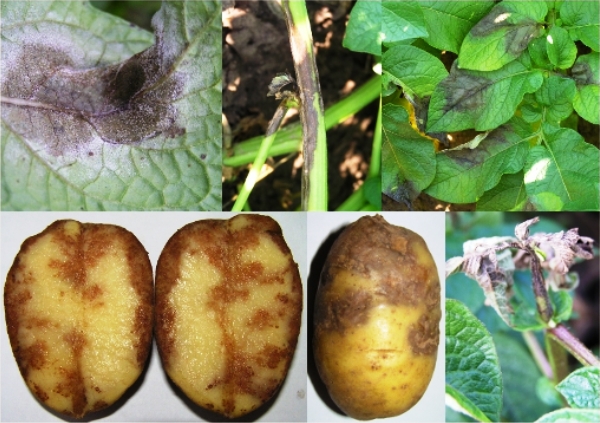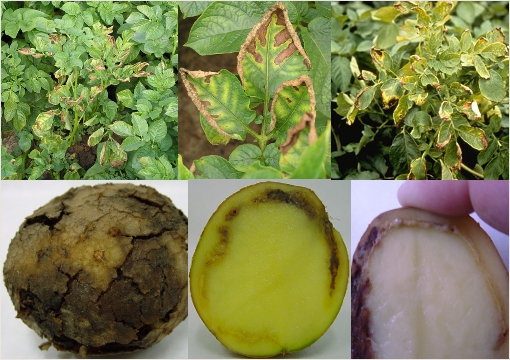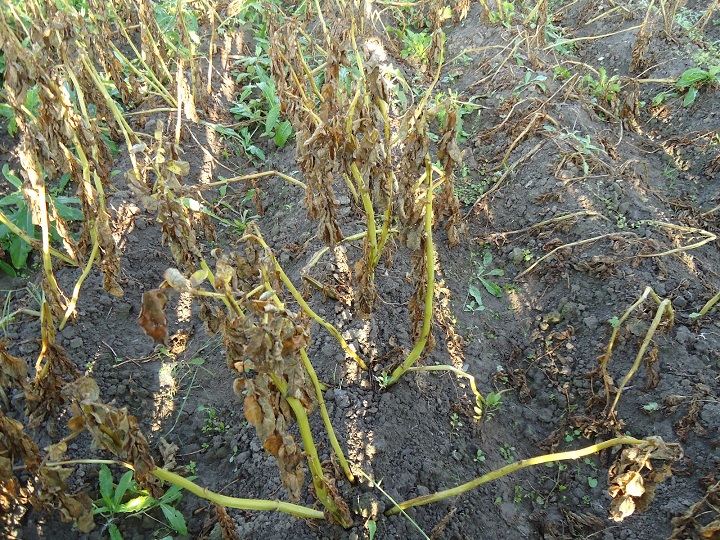Why is the potato tops dries? How to determine the readiness of potatoes for harvesting (maturity of tubers)
Potatoes can hardly be called a "capricious" culture. Perhaps that is why not every gardener pays attention to the fact that the potato leaves turn yellow. Meanwhile, a change in the color of the tops can signal the damage of plants by pests, viral or fungal diseases, as well as unfavorable conditions for the growing season.
To find out why the tops of potatoes turn yellow, look at the plantings:
1. With a lack of moisture, the lower tiers of leaves and flowers acquire yellow color, on top of that, the tops begin to crumble, the growth of the bush slows down. The solution is simple: adjust the regularity of watering.
2. A deficiency of magnesium or iron in the soil is manifested by blanching the lower part of the leaves and a slight yellowing. Feed the planting of potatoes with mineral fertilizers.
3. If the plant withers, and the tops quickly dries out, perhaps the potatoes do not have enough nitrogen. The introduction of the same "Azofoski" solve the problem.
4. In case of vertical ciliated wilting caused by the fungus, yellowing and twisting of the leaves starts from the bottom, brown dots are visible in the tuber section. Another fungal disease, fusarium, is characterized by wilting of the bush (including the apex) and blackening of the roots. As a rule, the source of fungal infections is poor quality planting material. Be sure to pickle the seeds, and after harvesting, treat the soil, burn the affected tops.
 Yellowing due to the fungus (in this case, phytophthora) leads to the appearance of black spots
Yellowing due to the fungus (in this case, phytophthora) leads to the appearance of black spots 5. If the potato turns yellow in August-September and at the same time the plant looks quite healthy, most likely there is no cause for concern. The process of extinction of the ground part of the bush during the "readiness" of tubers is absolutely normal, get ready to harvest.
6. The increase in temperature and humidity has a beneficial effect on the spread of ring rot. The top of the affected bush is twisted, the tops turn yellow and disintegrate. If you cut the potato, you will see rot, ring "shingles" tuber. In order not to expose the crop to danger, plant only tested, healthy tubers into the ground, and destroy diseased plants in a timely manner.
 Ring rot is easier to recognize by tuber than by leaf
Ring rot is easier to recognize by tuber than by leaf 7. Black foot often spoils the young shoots. The roots and bases of the stems are covered with rot, and the foliage turns yellow. Before planting, it is imperative to sort the tubers and process them with fungicides, do not regret the infected plants - such bushes will have to be burned.
8. During viral diseases, the potato leaves turn sharply yellow, in general, the bushes noticeably lag behind, and the stems die off. There is a decline in yields, and those tubers that have managed to grow, surprise with its "irregular" shape. Viruses are transmitted through parent tubers, along with soil or implements. The fight against the disease comes down to the destruction of infected landings.
 Potato viruses deform tubers
Potato viruses deform tubers 9. Often the yellowing of the leaves is associated with the appearance of insects in the plantings. It is difficult to make a mistake in making a diagnosis: usually pests are visible to the naked eye. A banal gathering of adults and larvae, spraying plants with insecticides, “neighborhood” unpleasant for insects of calendula or legumes will help against the invasion.
10. Consider the fact that over-feeding or a violation of the fertilizer application scheme can also cause premature yellowing of the tops of the potato.
WHY YELLOWS BOTTLE OF POTATO? - Why the tops of potatoes turn yellow. Signs of phytophtora.? According to the tops of potatoes, one can judge the future harvest. If the tops of the potato turn yellow, then this is the first sign of phytophthora of potato (late blight). As a rule, late blight begins to appear during the flowering (budding) of potatoes. Following the yellowing of the potato tops, the wilting of the leaves and the premature drying of the bush begin. The crop at the same time decreases almost twice. At the initial stage of this disease, the leaf surface should be treated with water with a certain concentration of copper sulfate in it. At the advanced stage of this disease, the only way out of this situation will be to burn the leaves in the process of harvesting potatoes and then sort the tubers from these bushes. Signs of potato phytophthora can be identified during the germination of seed tubers in sunlight. Infected tubers do not withstand the influence of ultraviolet radiation and begin to rot already on the 7-10th day. Also, the potato leaves turn yellow due to the lack of potassium and phosphorus due to depleted soil. The main danger of phytophtoras is to reduce the growing season of potatoes by almost two times. Yield from such contaminated sites rarely exceeds 250 kg per hundred (250 centners per hectare). Tubers in such bushes are small, because the bulk of the nutrients accumulate in the stem of the potato bush, and he, in turn, does not have time to gain the necessary mass. As a rule, one stem is 1 tuber. By the number of stems in the bush, you can indirectly determine the number of main tubers in this bush. And the mass of the stem - respectively, about the mass of the tuber. I want to immediately notice that we are talking about an elite potato, because A degenerate potato variety usually has a greater number of tubers, to the detriment of their quality. Earlier, about five years ago, I came across bushes, where the number of tubers reached 20 pieces. But the size of the tubers in such bushes did not exceed the size of the tenis ball, or even less. If the stem is thin, this is the first sign of nitrogen deficiency (assuming good watering). If the search engine to enter a query: "why the potato tops turn yellow forum" you can immediately find several sites with questions and discussions on similar topics. But the conclusion in most of them will be exactly the same. I remember well that year when almost half of the plot of potato tops turned yellow and withered almost during budding (flowering). This is another reason why I now sprout potatoes in advance in sunlight. Planting tubers of potatoes that are affected by late blight, even before planting will make themselves felt. It will be easy to reject them during the landing. Regarding the phytophthora or not, you can still determine how, the fact is that it greatly reduces yields, it often happens that there is only one potato per stalk. Potato shallows. In any case, pay attention next time to planting material. It is best to germinate potatoes in the light, then in a few days the potato laitum by the blight will start to rot, and thus it can be rejected. In fact, it may well be that the soil is simply poorer, you somehow fertilize it. Can you plant green manure, or nitroammofoskoy? If the matter is in the depletion of the soil, then I advise just the nitroammophore until autumn, it must lie in the ground for the winter, so it decomposes. Even potatoes ahead of time could ripen because of the heat, or lack of watering. Compare how you are caring for a neighbor with potatoes, but I think that if there was a phytophtora, it would have spread to the neighbors' landings. So it remains. soil degradation, or weather conditions.
At home, in the Andes, potatoes are a perennial plant. But in our climate, already at a temperature of -1 ° C, the conversion of starch into sugar begins in the tubers, which makes the taste much worse. On the other hand, it is a pity to dig out unripe, small potatoes, and in the winter because of unformed rind, it is poorly stored. To collect the maximum yield before the onset of frost, it is necessary to accurately determine when the potato stops growing.
Signs of stunting. Flowering - a turning point in the development of potatoes. From the moment of emergence and before flowering, the tops grow much faster than the tubers, then the growth of the green mass slows down and gradually stops, and the plant gives most of its strength to the potato.
The purpose of potato tops is to supply tubers with photosynthesis products. In the yellowed, withered leaves and stems photosynthesis is impossible. Hence the logical answer to the question of whether the potatoes grow, if the tops are dried: of course not, because the tubers have no other place to take nutrients.
 Dry leaves and yellowed stems indicate cessation of potato growth
Dry leaves and yellowed stems indicate cessation of potato growth Determination of harvest time
After the tops of the tops of the potatoes in the ground are covered with a dense skin, so the plant is preparing for the winter. If you do not dig up the potatoes for two weeks, it may start to rot.
However, there are no rules without exception: tops of some varieties, especially later ones, can almost remain green and strong until frost. Often this happens on well-fertilized soils. The weather also affects the state of the shoots: heavy rains at the end of the growing season lead to the fact that the already wilted tops have come to life again and are growing. Because of this, the taste of the potato spoils: actively growing shoots draw off useful substances instead of giving them to tubers.
If the frosts are approaching, and the tops have not yet dried, it is better to hurry with the harvest. You should not wait for the complete withering of shoots affected by blight. It's easier for 10–14 days before digging up potatoes to mow the tops. Removal of the green mass will signal the cessation of potato growth and degradation of the peel.
Chemicals to accelerate the drying of the tops
When the shoots dry out naturally, the nutrients and moisture they contain go into tubers. If you mow very fresh tops, the potatoes will receive less of the due vitamins and microelements.
Therefore, many growers use chemical agents that provoke the premature wilting of the leafy tops. Such drugs are classified according to the type of effect on the shoots:
- desiccants - chemical compounds that dehydrate tops;
- means for the centering - desiccants, accelerating the process of natural aging and wilting of the tops.
The most common desiccation methods are:
- spraying with 0.5% solution of copper sulfate (50 g per 10 liters of water). The procedure is carried out 2 weeks before cleaning;
- spraying with a 2% solution of magnesium chlorate. The processing of one weave requires a solution of 200 g of magnesium chlorate in 10 liters of water. Leaves dry in 3–5 days after spraying.
Concentrated solutions of complex fertilizers, which act more slowly and more sparingly than conventional desiccants, are used for the curing process. Due to this, the tubers receive the maximum amount of nutrients from the tops.
Senication can increase potato yield by 10–15%.
The most popular preparation for the centering - a concentrated solution of superphosphate. For its preparation you need 2 kg of fertilizer per 10 liters of water. Superphosphate dissolves very slowly, so the suspension is prepared 2-3 hours before use. Fertilizer poured into the container, pour water and thoroughly stirred. After 1.5-2 hours, the liquid is poured into another vessel, and the precipitate is stirred. Both parts of the suspension are combined only after complete dissolution of all the granules.
Acceleration of potato ripening
Vegetable growers usually focus on ripening terms established for different types of varieties:
- up to 65 days - early;
- 65–80 days - medium early;
- 80–95 days - mid-season;
- 95–110 days - medium late;
- 110 - 120 days are late.
The problem is that these dates were calculated for ideal conditions. If the potatoes are planted in an insufficiently heated land, it will sprout and mature much later. In heat above +30 ° C, tuber development stops.
In order for the growth of potatoes to stop, the weather conditions and the nature of the soil must be taken into account. The easiest and most affordable way to accelerate the ripening of potatoes is to plant it not just with tubers, but with seedlings.
Seedlings are grown from whole or sliced potatoes, even from the eyes. The meaning of the method is that you need to plant a ready-to-start plant in the ground. If the spring is cool, it is recommended to use a film, spunbond or install small greenhouses above the potato beds.
A variety of growth regulators help accelerate the development and maturation of potatoes for at least a week. Typically, these drugs have a complex effect: strengthen the immune system of plants, protect them from fungal and viral infections.
The most popular growth regulators:
- "Poteytin" - low-toxic agent that increases the yield by 25%. It is used for preplant treatment of tubers and spraying during the growing season;
- Agat-25 K is a biological product with a fungicidal action, containing pseudobacterium Pseudomonas aureofaciens. Used for pre-treatment;
- Novosil is a remedy with triterpene acids (based on Siberian fir extract). It is used for spraying during the growing season.

